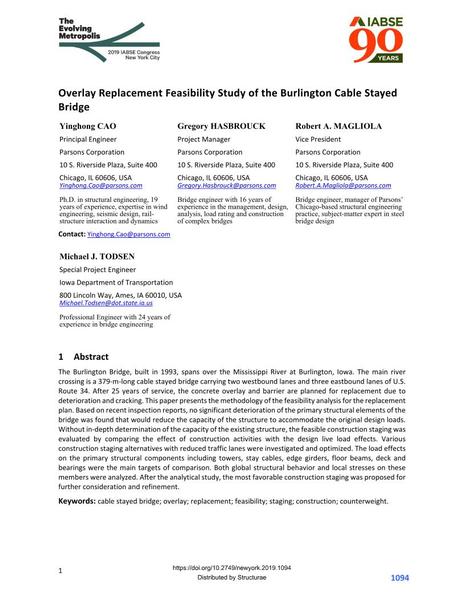Overlay Replacement Feasibility Study of the Burlington Cable Stayed Bridge

|
|
|||||||||||
Bibliographic Details
| Author(s): |
Yinghong Cao
(Parsons Corporation)
Gregory Hasbrouck (Parsons Corporation) Robert A. Magliola (Parsons Corporation) Michael J. Todsen (Iowa Department of Transportation) |
||||
|---|---|---|---|---|---|
| Medium: | conference paper | ||||
| Language(s): | English | ||||
| Conference: | IABSE Congress: The Evolving Metropolis, New York, NY, USA, 4-6 September 2019 | ||||
| Published in: | The Evolving Metropolis | ||||
|
|||||
| Page(s): | 1094-1099 | ||||
| Total no. of pages: | 6 | ||||
| DOI: | 10.2749/newyork.2019.1094 | ||||
| Abstract: |
The Burlington Bridge, built in 1993, spans over the Mississippi River at Burlington, Iowa. The main river crossing is a 379‐m‐long cable stayed bridge carrying two westbound lanes and three eastbound lanes of U.S. Route 34. After 25 years of service, the concrete overlay and barrier are planned for replacement due to deterioration and cracking. This paper presents the methodology of the feasibility analysis for the replacement plan. Based on recent inspection reports, no significant deterioration of the primary structural elements of the bridge was found that would reduce the capacity of the structure to accommodate the original design loads. Without in‐depth determination of the capacity of the existing structure, the feasible construction staging was evaluated by comparing the effect of construction activities with the design live load effects. Various construction staging alternatives with reduced traffic lanes were investigated and optimized. The load effects on the primary structural components including towers, stay cables, edge girders, floor beams, deck and bearings were the main targets of comparison. Both global structural behavior and local stresses on these members were analyzed. After the analytical study, the most favorable construction staging was proposed for further consideration and refinement. |
||||
| Keywords: |
construction replacement staging counterweight feasibility cable stayed bridge overlay
|
||||

